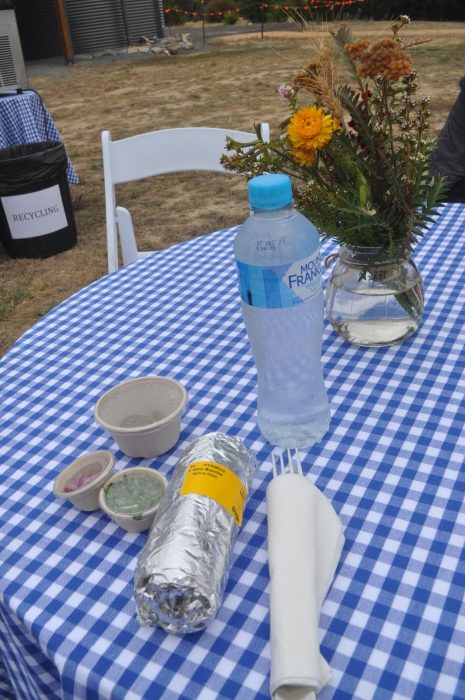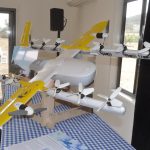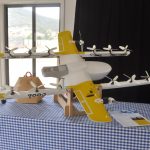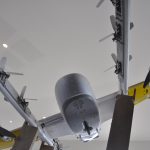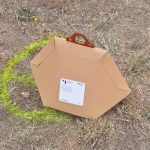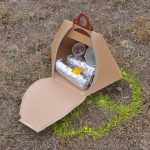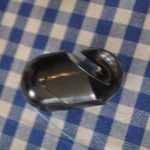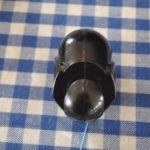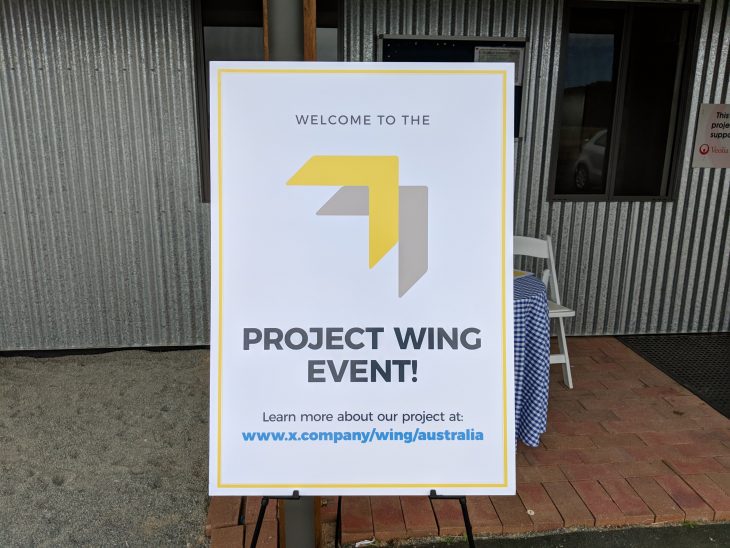
It’s a mild, overcast day and I’m in a field just outside of Canberra waiting for my lunch to be delivered. It’s a delivery with a difference with the spicy chicken burrito from Guzman y Gomez being delivered by Alphabet’s X companies Project Wing.
The drone delivery service has been testing in the Canberra region, or just outside in the Fernleigh Park area just outside of Queanbeyan since last year. They’ve been delivering pharmacy products such as mascara, tissues and the like – but not prescription based meds – and burritos from partners Chemist Warehouse and Guzman y Gomez. In that time they’ve completed around 600 deliveries, all the while working with the locals to minimise the disruption, safety and privacy concerns a drone in the area can raise.
According to Project Wing Co-Lead James Ryan Burgess, the project has taken pains to reach out and address concerns of local residents. They worked with one local horse breeder concerned about the effect on the horses. After careful tests in co-operation with the breeder, it seems that the horses are fine with drones: indeed the helicopters that fly over the area seem to have gotten them used to the noise.
The drone delivery service is being utilised by a select group of residents in the area using a special Android and iOS app. Users who sign up to the trial, all of whom attended a local BBQ in the area to introduce the Project Wing concept and service to the area and locals, are white listed and get access to the app.
There’s no delivery fees yet, Project Wing is still working on that aspect, but delivery is fast. We placed our orders for burritos and they’re there within minutes, delivered from a ‘Nest’ which houses the solar powered charging stations for the drones, sensors and of course the food truck a few kilometres away.

The drone delivery service has quite a small carbon footprint, and ties in with Project Wing’s goal of reducing road congestion and reduce accidents. A study by RSG and Professor Goodchild from the University of Washington found that the drone delivery service generates 22 times fewer carbon emissions than a delivery vehicle over an average delivery trip in Canberra.
The drones fly fast – up to 130km per hour – at around 30-60 metres in height. They utilise a cloud based Unmanned Traffic Management (UTM) system for navigation that’s cloud based and uploads navigation data via on-board Wi-Fi and LTE to the drone, to navigate from the Nest to the customers location. There are cameras built-in as well for additional navigation aids.
Customers have several points located near them to select currently, with trials on large properties offering this option, though that will change once they get into more urban areas – more on that soon.
The UTM is Project Wing’s special sauce, which they hope to use and license to third parties – though they are aware of, and welcome other companies such as Amazon who are working on their own delivery drones. UTM allows Project Wing to build paths for the drone that avoid places like well known drone flying spaces to minimise disruption to hobbyist drone pilots, and they’re working with drone manufacturers to add in tools that will help avoid drone collisions.
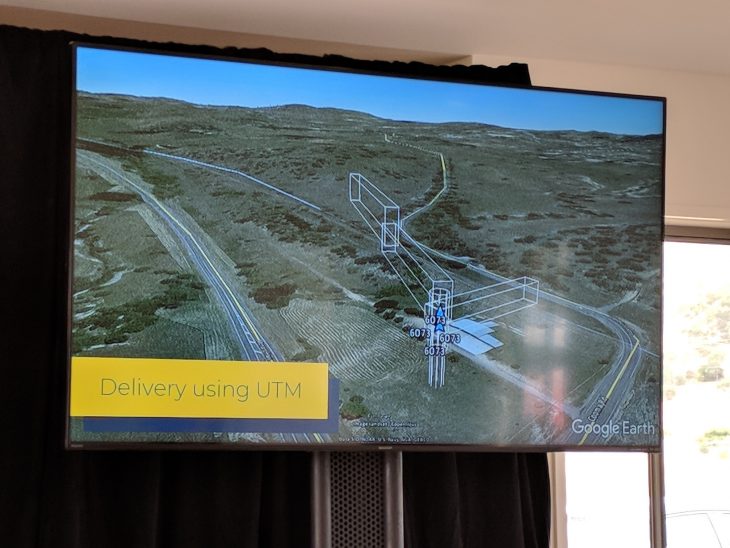
Project Wing is working in Australia thanks to our favourable conditions both with the Civil Aviation Safety Authority (CASA), as well as local and state regulators with the Canberra region being quite welcome. Previously Mr Burgess has spoken about how the open fields and terrain of the Canberra region is favourable to Project Wing and the testing they’re currently doing.
Project Wing is also hoping to use their UTM to allow them to fly in areas not normally allowed by drones like near airports – but they’re working very closely and slowly with CASA and the FAA on this aspect. Safety seems to be very much at the forefront of everything Project Wing is doing here.
It’s very much here in Australia that Project Wing has done most of their testing. They did initial testing in the US, but again it was the favourable conditions in Australia that first led them to perform the first of their drone deliveries in QLD, delivering dog treats and bottled water with delta wing design aircraft that is vastly different to the current model of drone used by Project Wing today.
The current drone has 14 rotors built-in to it. There are 12 for vertical flight and two for forward momentum, with built-in redundancy to account for the event of a failure. The design is still a wing design and it’s this shape that allows the drone to save some energy when making deliveries. The range of the Project Wing drone is around 20 km round-trip. At the end of which, it hovers around 5-10 metres from the ground over the pre-determined location and lowers its cargo to the ground.
The actual delivery of a package by drone is entrancing to watch. The drone flys in across the paddocks, then hovers before a winch winds down your package. The drone, which weighs about 4.5kg, can carry a payload of about 1.5kg (about 4 burritos, or a combo of burritos and sides).
The packaging used for delivery is very much ergonomically designed for reduced wind resistance when it’s winched up into the belly of the drone for flight. It’s made of recyclable cardboard which is covered in a waxy coating to ensure that it both protects the food from any rain – though the drone doesn’t currently fly in either rain or high wind conditions – and keeps the food warm. The burrito it delivered was as fresh as if it were just handed over the counter at the local store – the Project Wing team has tested it with coffee deliveries and the result was a cup of coffee just as warm as if it were freshly brewed.
The winching system is simple at first glance, but Mr Burgess says it’s one of the more complex aspects they had to design with the hook still in evolution. It has to be safe for both the staff loading the drones, and the customers receiving the delivery. If the hook gets caught up on something, or a customer doesn’t want to let go, the drone just disconnects the hook and spool and flys off.
There are currently five drones operating in the test area for Project Wing, but they plan to expand their fleet to 10 when they expand to Bonython in the Tuggeranong region of Canberra in the next week.
There are a potential 50,000 new testers in the Bonython region, with Project Wing holding another of their BBQs this weekend – February 24th – at the Pine Island Reserve to engage the local community and they’ll be in contact with Bonython residents in the coming weeks to invite expressions of interest in taking part in the trial.
Project Wing is thinking about extending the range of products and services offered for delivery, based on the switch from a rural to a more urban setting, but is sticking with Chemist Warehouse and Guzman Y Gomez for now.
As for a broader launch, there’s no specific dates, but a commercial launch later this year isn’t out of the question said Mr Burgess.
The lunch for me, witnessing several burrito deliveries, was absolutely transfixing. Hearing the details of the progression from concept to where the current delivery system is currently at was also as interesting as watching the deliveries. There is a lot of work that goes on behind the scenes in the cloud with machine learning powering the UTM and even just the process of hooking up a delivery to the drone and then watching it be delivered. For me, drone deliveries have a lot of promise and I can’t wait to do it again.
Daniel travelled to Royalla at his own cost, but Project Wing purchased him a burrito – it was delicious.
